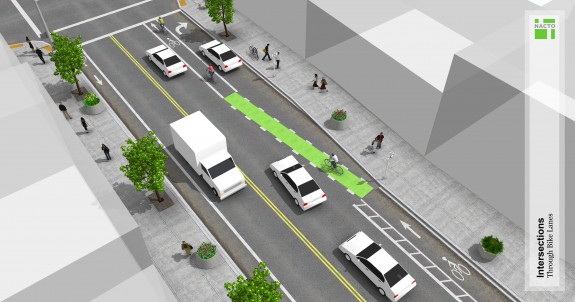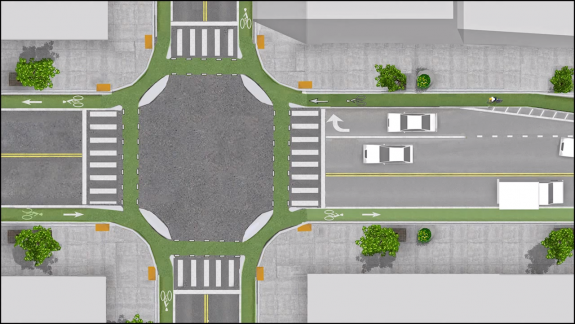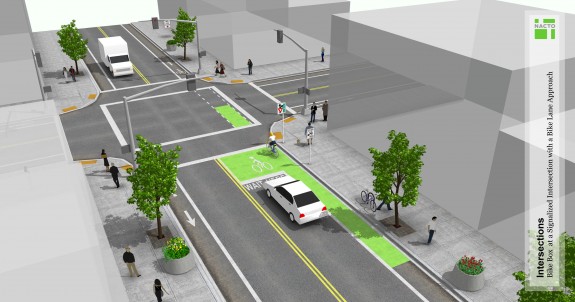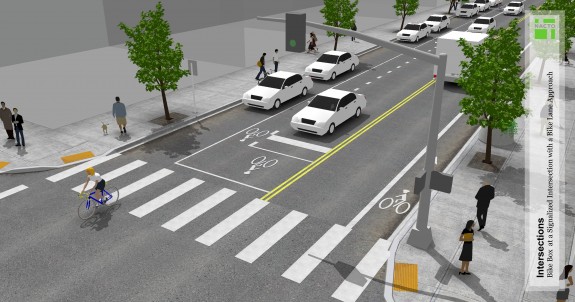With all of the progress the city has made in recent years making streets safer and easier for biking, there is a clear lack of changes at intersections. Sometimes the city is afraid of removing current dedicated right turn lanes for fear that traffic will back-up. Sometimes there are safety fears associated with putting people on bikes to the right of right-turning cars. Sometimes it seems the city just doesn’t know what to do, so they slap some sharrows on the right-turn lane and call it a day.
But it’s time to get over our fear of bike facilities through intersections. The city is taking a few small steps to do so, but we need to do more. These are the moments when people need safe facilities the most, and there are far better ways we could be using our intersection space so that it works better for everybody (including people driving and walking).
 The relatively new NACTO Urban Bikeway Design Guide suggests having right-turning cars cross the bike lane before the intersection, thus removing the intersection conflicts. Seattle has a small handful of intersections like these, including Dexter near Mercer and Denny and N 34th St near Fremont Ave.
The relatively new NACTO Urban Bikeway Design Guide suggests having right-turning cars cross the bike lane before the intersection, thus removing the intersection conflicts. Seattle has a small handful of intersections like these, including Dexter near Mercer and Denny and N 34th St near Fremont Ave.
In Seattle, busy intersections with this NACTO-approved design are some of the best, especially if the goal is to allow as many right turns on red as possible (and we love right turns on red in America, despite the fact that almost no other nations allow them).

However, as the video above — by A view from the cycle path — points out, right-turning cars cross the bike lane at a less-than-ideal angle, and drivers need to look over their shoulders to see any people on bikes coming up on their right. They suggest designing intersections like the Dutch do.
I would love to see something like this tried here. It might make right turns on red a little more difficult, but the advantages to safety for all users is huge. Cars would not be able to fly around corners (dangerous for other motorists as well as people walking and biking) because the corner would be more squared-off. People walking will effectively have a shorter distance to cross because of the added protection from the extended curb. And, of course, many conflicts for people biking are avoided.
 The city has also been experimenting with bike boxes, and the N 34th St bike box has been extremely successful and is popular. It would be great if bike boxes simply became a regular part of Seattle street design. And if the green paint is cost-prohibitive, then maybe we should just skip it:
The city has also been experimenting with bike boxes, and the N 34th St bike box has been extremely successful and is popular. It would be great if bike boxes simply became a regular part of Seattle street design. And if the green paint is cost-prohibitive, then maybe we should just skip it:
 I would rather have lots of unpainted bike boxes (basically just advance stop lines) than just a couple green ones. By having cars stop a few feet further back from the intersection, visibility for people walking and biking increases significantly. Of course, this would sometimes require banning right turns on red (like on Pine at 12th on Capitol Hill).
I would rather have lots of unpainted bike boxes (basically just advance stop lines) than just a couple green ones. By having cars stop a few feet further back from the intersection, visibility for people walking and biking increases significantly. Of course, this would sometimes require banning right turns on red (like on Pine at 12th on Capitol Hill).
If we want more people to take up cycling, we will need to make sure our streets (especially our bike routes) are safe from start to finish. Skipping every difficult intersection simply does not cut it. We can’t keep leaving people hanging at the exact moments when they need safe facilities the most.








Comments
20 responses to “It’s time to start designing safer intersections”
One problem I see with this is that extending the curbs out into the intersection to make room for the green bicycle lanes makes it more difficult for large trucks to negotiate right turns.
That’s a benefit, not a problem.
Well, they’d probably end up riding up over the “protective” curb. Which would be dangerous.
It’s dangerous for the cyclist standing at the ‘wait’ to cross spot. And the truck is likely to destroy the curb riser with repeated turns. Or worse, use the on coming traffic lane to the right to make the swing.
But I see the point of this design and it looks right except for left turns, where you’ll probably find me in the left hand turn lane with the cars.
I think the idea with the Dutch design is to think of it as a “bike roundabout”. I can see, though, why left turners might rather cut across the intersection if they think it safe.
Also, I think those designs would work better on areas away from truck routes.
And unless Washington changes its laws, you would be perfectly welcome in the left turn lane if you choose to do so. Doing the two-step left would work for others who don’t mind waiting or if there is significant traffic in the way making the merge difficult. I see it as providing more options.
And depending on the intersection, if it is determined that freight would have a hard time making the turn on a high-priority freight route, I could see that as a reasonable argument to use a different design. I don’t think that is a good argument for non-priority freight routes, though. A couple trucks per day being slightly inconvenienced is not a good reason not to make a road safe. But at a certain point, it makes sense not to have a ton of trucks running over a curb all day long. It’s all about balance. This is something that could be addressed if the freight master plan ever gets funding.
I completely agree Tom…my enthusiasm for the 34th st intersection has dampened a bit after watching this video. Is there any reason why SDOT can’t start installing intersection treatments like this, short of funding? For what it’s worth, I would be absolutely willing to chip in to pay for some bicycle infrastructure upgrades around the city.
This junction design seems like a pain for cyclists going straight through green lights. With the old design you could go straight at 20 mph, but with this design you have to do the crazy zig-zag at every stoplight. That would get annoying as heck really quickly.
I think that a better idea is to place the bike path to the left of the traffic lane like is done on Ravenna blvd.
But how would this work at, say Dexter & Denny, where the crossover bike lane only goes straight on Dexter and there’s no option to turn onto Denny?
It wouldn’t work everywhere. Mainly it would work at crossings where both streets have bike lanes (or maybe where one has bike lanes and the other has on-street parking?)
Basically, my point is that there are options out there other than simply letting the bike lanes drop. No one design is going to work everywhere.
N 34th St near Fremont Ave, to the east of the intersection, is a bad intersection for other reasons than those in the video. Most importantly, the right lane is not a right-turn-only lane; instead it is a right-turn *and* through-traffic lane. This means that immediately after the intersection, straight-proceeding cars in the right lane have to haphazardly get to the left of bicyclists again. Furthermore, parking is allowed in this lane at some times of day, which obstructs through traffic and forces them to cross the bike lane at a point other than where it is desirable.
The first problem could be easily resolved by making the middle lane a left-turn and through-traffic lane, and making the right lane a right-turn-only lane. The second problem could be resolved by eliminating parking in the right lane within 100 feet of the intersection. There is really no reason to allow parking so close to such a busy intersection in a manner that significantly obstructs traffic.
That intersection is really baffling for all the reasons you mention. Having the through lane on the right of the bike lane has to be against the rules design. When I approach the intersection from the east, my guy reaction is that the lane to the left of the bike lane is a “Left and Straight” lane *every* time, even though I know that it isn’t.
I wonder why it’s like this?
My guess is that because the vast majority of bicycle and motor vehicle trips are making a left vs going straight, it made sense to do it the way they did. This way, the bike lane can get a free left turn to go over the bridge. In the few instances where a person biking and driving both want to go straight, it is into a very low-traffic stretch of road.
I agree that it is a little awkward, and maybe there is a way to do it better. 34th west of Fremont is basically a one-way street (with a counterflow bike lane). Maybe they could paint sharrows on the left side to indicate where to ride or turn that counterflow lane into a two-way bike lane.
The bike lane should just be marked a left-turn only lane. Cyclists going straight should use the right lane. All the city has to do is paint a left-turn arrow above the bike icons in the bike lane/box, and paint sharrows down the middle of the right lane. Easy as pie.
I’ve never really liked the designs that put the bike lane on a diagonal and have turning traffic go all the way across. I much prefer having the bike lane turn into a shared lane for bikes and right turns.
The problem I see with this “new” Dutch design is how it moves the conflict. The problem with drivers having to look over their shoulder for cyclists to cross over the bike lane (or merge into it, in my preferred design) isn’t nearly as much of a problem as they think. Drivers are usually going faster than cyclists as they approach this point, so the cyclists are in front of them as they’re planning the maneuver. It’s an easy and obvious one to make, and the cyclist doesn’t even have to see the driver for it to be performed safely. In the new design, at the point of conflict, cyclists are overtaking drivers — that is, cyclists that drivers passed before turning are now overtaking them again. It’s harder for drivers to judge where they’ll be relative to these cyclists as they approach the intersection, especially because the cyclists are swerving around, and more likely that drivers will make a turn in ways that will force cyclists to emergency-stop. It’s the same set of problems that you have if you put bike lanes to the right of right turns, and the same set of problems cyclists have when they ride in the sidewalk, or cross 15th Ave NE on the Burke, or use Chicago’s Lakefront trail at Grand Ave — all places where cyclists are prone to getting hooked by right-turning traffic.
It looks like an intersection along the Capitol Hill streetcar line will be getting an intersection treatment very similar to the Dutch one in the video.
Check it out: http://www.seattlestreetcar.org/about/docs/nov/09-bway-yesler-aerial.jpg
One thing that’s important to know about this type of intersection design is that the timing in the cycle for cyclists and pedestrians crossing is different than the cars turning right. They’re not crossing at the same time.
@Clark: So… there’s not only no right-on-red or left-on-green, but no right-on-green either?
It sounds like there must be a lot of different light phases to make that work. Dedicated turn phases usually mean no crossing for pedestrians, so wouldn’t that decrease total walk-time and increase pedestrian/bike wait time? So what fraction of the time to bikes/peds get to go? Do turning motorists have a long wait (that might affect political support, especially in areas without much pedestrian traffic)?
Right-turn-on-reds for motor vehicles are not permitted in the Netherlands, or most countries in the world for that matter. But at a typical Dutch junction as seen above, cyclists can make a right turn without having to stop because the traffic lights sit to their left and do not apply to them. See here for an explanation: http://bicycledutch.wordpress.com/2012/10/25/cycling-past-red-lights-its-legal-in-the-netherlands/ Even within a city in the Netherlands, the junctions are never exactly the same. See this link about trucks: http://bicycledutch.wordpress.com/2013/11/20/cycling-and-trucks-dutch-way/